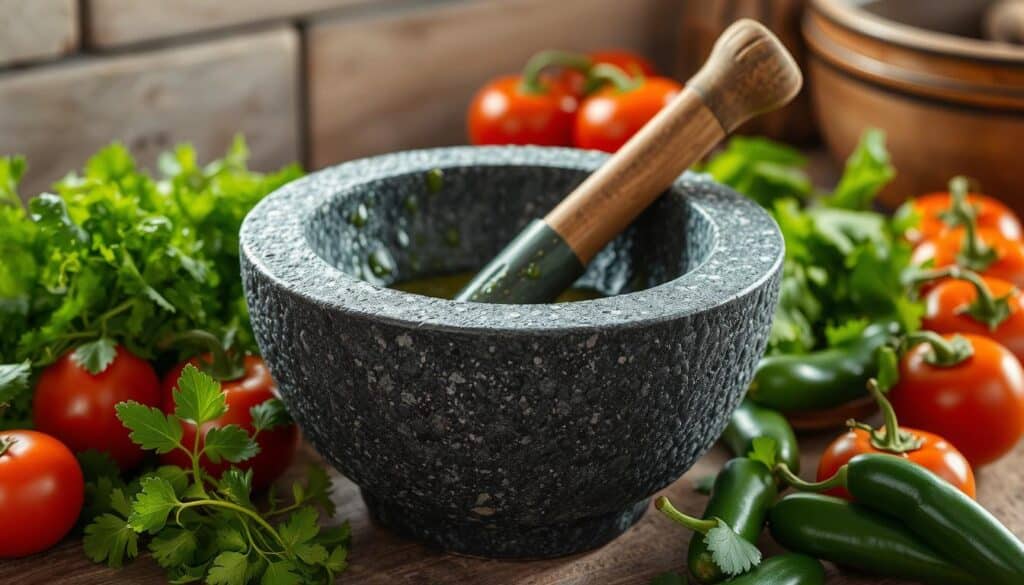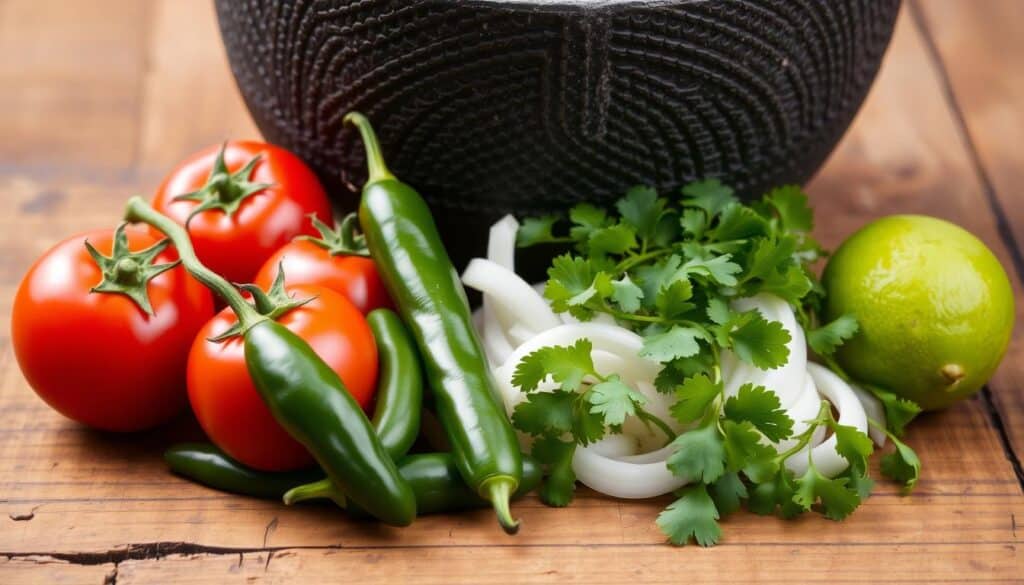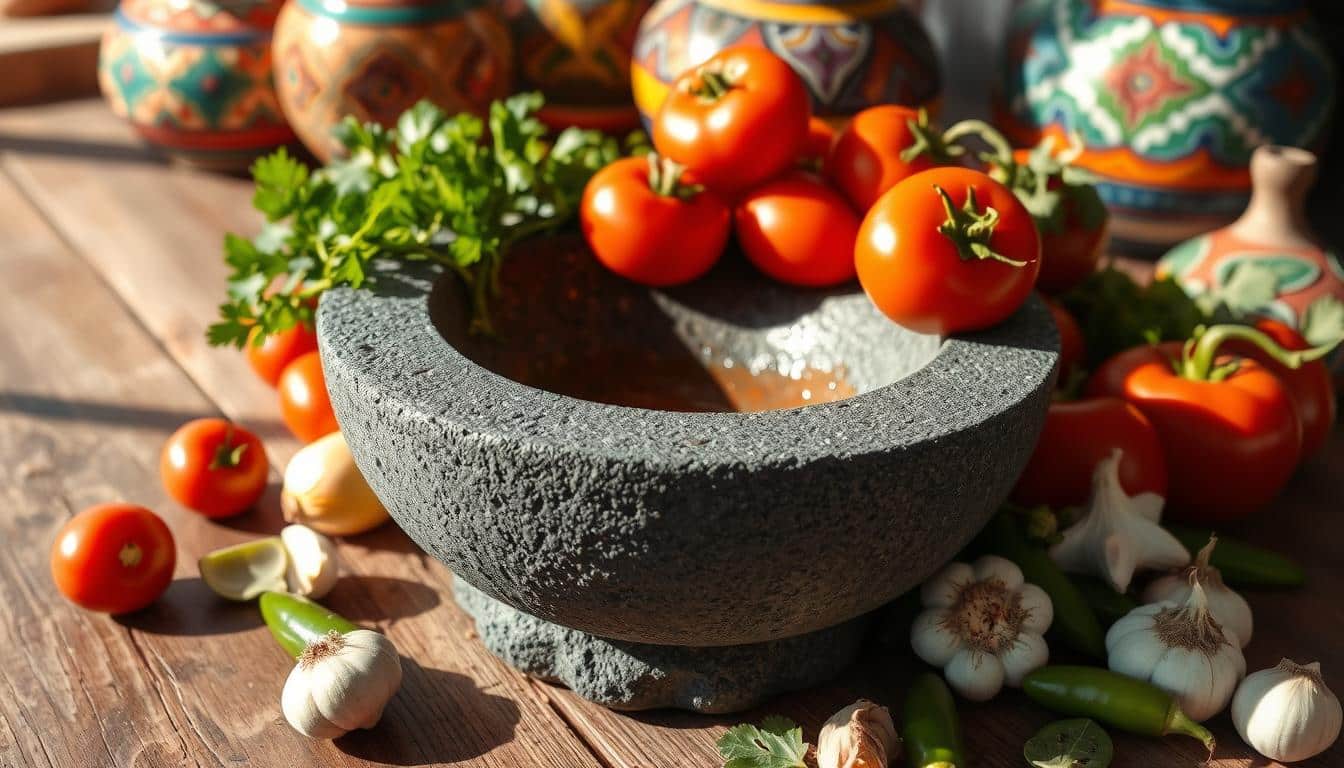The molcajete is a key part of Mexican cooking. It brings centuries of tradition into our homes. This ancient stone tool is vital for making authentic molcajete recipes that are full of flavor.For a comforting dish steeped in tradition, explore our Classic Oxtail Recipe, which is fall-off-the-bone tender and rich with flavor. View Recipe.
We will learn how to make the perfect salsa with this old method. It’s a journey into the heart of Mexican cooking.
Our adventure with the molcajete starts with its special ability to release flavors. The volcanic rock’s rough texture grinds ingredients better than modern tools. This makes salsas rich and full of character, just like true Mexican food.
As we explore this recipe, we’ll find out how to make salsa as good as restaurants. We’ll learn about choosing the freshest ingredients and mastering the grinding technique. Every step is important to honor this cooking tradition.
Key Takeaways
- Molcajetes are essential for authentic Mexican salsa
- The stone texture enhances flavor extraction
- Traditional methods surpass modern tools in taste
- Fresh ingredients are key for the best results. To complement your molcajete salsa, explore our Dessert & Juices Collection, offering a variety of refreshing and sweet recipes to complete your meal. View Recipes.
- Proper grinding technique impacts salsa quality
- Homemade salsa rivals restaurant versions
Understanding the Ancient Art of Molcajete Grinding
The molcajete is a key part of Mexican cooking. It has been grinding ingredients for centuries. Let’s look at its history and why it’s loved today.Pair your salsa with easy and creative dishes from our Rotisserie Chicken Leftover Recipes, perfect for a quick meal upgrade. View Recipe.
History and Cultural Significance of Molcajetes
Molcajetes come from before the Spanish arrived. The Aztecs and Mayans made them from volcanic rock. They used them to make tasty salsas and sauces.

Different Types of Molcajetes
Most molcajetes are made of basalt. But, you can also find them in other materials. Here’s a quick comparison:
| Material | Durability | Flavor Imparting | Maintenance |
|---|---|---|---|
| Basalt | High | Yes | Low |
| Granite | Medium | No | Medium |
| Marble | Low | No | High |
Benefits of Using a Molcajete vs Modern Tools
Using a molcajete might seem hard, but it’s worth it. It doesn’t heat up ingredients like blenders do. This keeps their flavors raw.
The stone’s surface adds a special taste to your food. Grinding by hand also lets you control the texture better.
“The molcajete is not just a tool, it’s a connection to our culinary heritage.”
Essential Ingredients for Authentic Molcajete Salsa
Making the perfect molcajete salsa starts with the right ingredients. We’ll look at what makes this traditional Mexican dish so flavorful and authentic.
Fresh Vegetables and Herbs Selection
The base of a great salsa is fresh produce. For a classic molcajete salsa, we use ripe tomatoes, onions, and cilantro. Jalapeños or serrano peppers add heat, and garlic adds depth to the flavor.

Traditional Spices and Seasonings
Molcajete seasoning includes salt and cumin. Some recipes add lime juice for extra flavor. The molcajete grinds these spices, releasing their oils and making the taste stronger.
Regional Ingredient Variations
In Mexico, molcajete salsa recipes change based on local tastes and ingredients. Coastal areas might add seafood, while inland regions use unique chili peppers.
| Region | Unique Ingredient | Flavor Profile |
|---|---|---|
| Yucatán | Habanero peppers | Fiery hot with fruity notes |
| Oaxaca | Chapulines (grasshoppers) | Nutty and crunchy |
| Baja California | Fresh seafood | Briny and refreshing |
Knowing these key ingredients helps you master molcajete salsa. Try different mixes to find your favorite flavors and textures.
Basic Molcajete Recipe: Step-by-Step Guide
Making the perfect molcajete sauce is an art that needs patience and practice. We’ll guide you through it, from getting your molcajete ready to making your salsa just right.
Preparing Your Molcajete
Before grinding, season your molcajete. Grind uncooked rice until it’s powder without gray specks. Rinse and repeat to remove loose particles and smooth the surface.
Grinding Technique Tips
To make authentic salsa, learn how to use your molcajete well. First, grind garlic and salt into a paste. Then, add chiles and grind in a circle, pressing hard. Add tomatoes last because they’re the juiciest.
Achieving Perfect Texture
The perfect salsa texture is a mix of chunky and smooth. Grind to your liking, but don’t overdo it to avoid a watery salsa. Taste and adjust seasonings and texture until it’s just right.
- Grind harder ingredients first
- Use a circular motion with steady pressure
- Add juicy ingredients last
- Adjust texture and seasoning to taste
Follow these tips to master making Mexican salsa with a traditional molcajete.
Creating the Perfect Salsa Consistency
Making the perfect molcajete salsa recipe is all about getting the right consistency. Texture is very important in salsa. Some like it chunky, while others prefer it smooth. A molcajete helps you make different textures.
For a chunky salsa, grind ingredients just a bit. This way, tomatoes and onions stay chunky. It’s great for dipping chips or topping tacos. For a smoother salsa, keep grinding until it’s all mixed up.
To change the salsa’s thickness, it’s easy. Add more tomatoes for a thinner salsa. Or, add extra chilies and onions to make it thicker. Remember, grinding makes the salsa juicier, so it might get thinner.
| Consistency | Grinding Time | Best Uses |
|---|---|---|
| Chunky | 1-2 minutes | Dips, taco topping |
| Medium | 3-4 minutes | Enchiladas, burritos |
| Smooth | 5-6 minutes | Sauces, marinades |
Getting the flavors right is important for a great molcajete salsa recipe. Keep tasting and adjusting the salt, lime juice, or spices. With practice, you’ll get better at making the perfect salsa every time.
Common Mistakes to Avoid When Using Your Molcajete
Learning to use a molcajete takes time. We’ve listed common mistakes and how to fix them. This will help you enjoy your traditional Mexican mortar and pestle more.
Proper Cleaning and Maintenance
One big mistake is using soap on your molcajete. Don’t do it! Clean it with warm water and a stiff brush instead. For tough spots, grind uncooked rice to soak up oils and smells.
Storage and Care Tips
Storing your molcajete wrong can harm it. Keep it dry to stop mold. Also, don’t let it go from very hot to very cold, as it might crack.
Troubleshooting Common Issues
If your salsa feels gritty, your molcajete might need seasoning. Season it by grinding rice, cumin seeds, and rock salt until it’s clean.
| Issue | Cause | Solution |
|---|---|---|
| Gritty texture | Unseasoned molcajete | Re-season with rice and spices |
| Foul odors | Food residue | Clean with lime juice and salt |
| Cracks | Thermal shock | Avoid extreme temperature changes |
By avoiding these mistakes, your molcajete will last a long time. It will keep making authentic Mexican flavors in your kitchen.
Conclusion
We’ve looked into the rich tradition of authentic molcajete recipes. This is a key part of Mexican cuisine. The molcajete is more than just a tool for food; it’s a link to centuries of cooking history.
Using a Mexican molcajete connects us to old cooking ways. It makes our salsas taste unique and feel special. The grinding action releases oils and mixes ingredients in a way modern tools can’t.
We suggest you try using a molcajete in your kitchen. Try new ingredients and methods to make your own special salsa. Remember, getting better at grinding and finding the right mix takes practice.
Starting your molcajete adventure is not just about the taste. It’s also about the cultural experience it brings to your home. Enjoy the journey!

